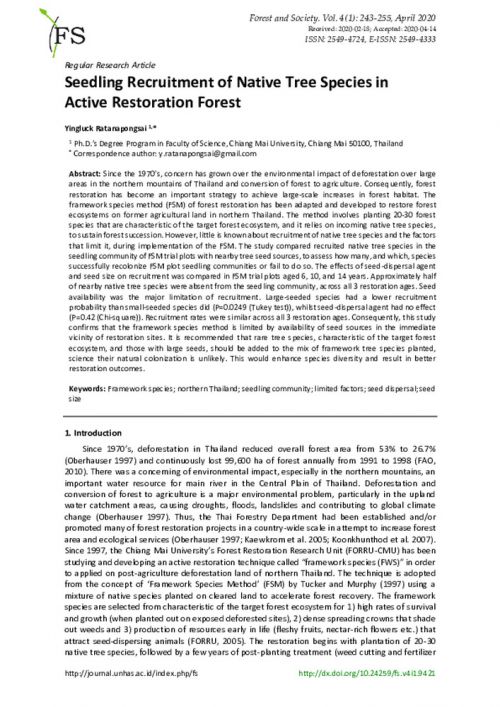Seedling recruitment of native tree species in active restoration forest

FORRU Contributors
Abstract: Since the 1970’s, concern has grown over the environmental impact of deforestation over large areas in the northern mountains of Thailand and conversion of forest to agriculture. Consequently, forest restoration has become an important strategy to achieve large-scale increases in forest habitat. The framework species method (FSM) of forest restoration has been adapted and developed to restore forest ecosystems on former agricultural land in northern Thailand. The method involves planting 20-30 forest species that are characteristic of the target forest ecosystem, and it relies on incoming native tree species, to sustain forest succession. However, little is known about recruitment of native tree species and the factors that limit it, during implementation of the FSM. The study compared recruited native tree species in the seedling community of FSM trial plots with nearby tree seed sources, to assess how many, and which, species successfully recolonize FSM plot seedling communities or fail to do so. The effects of seed-dispersal agent and seed size on recruitment was compared in FSM trial plots aged 6, 10, and 14 years. Approximately half of nearby native tree species were absent from the seedling community, across all 3 restoration ages. Seed availability was the major limitation of recruitment. Large-seeded species had a lower recruitment probability than small-seeded species did (P=0.0249 (Tukey test)), whilst seed-dispersal agent had no effect (P=0.42 (Chi-square)). Recruitment rates were similar across all 3 restoration ages. Consequently, this study confirms that the framework species method is limited by availability of seed sources in the immediate vicinity of restoration sites. It is recommended that rare tree species, characteristic of the target forest ecosystem, and those with large seeds, should be added to the mix of framework tree species planted, scince their natural colonization is unlikely. This would enhance species diversity and result in better restoration outcomes.

